Stir-Fried Miso Eggplant is a gorgeous combination of flavors! Serve it as a main course or side dish with any meal on a busy weeknight. You need only basic pantry ingredients for this quick yet satisfying recipe that’s ready in just 20 minutes.
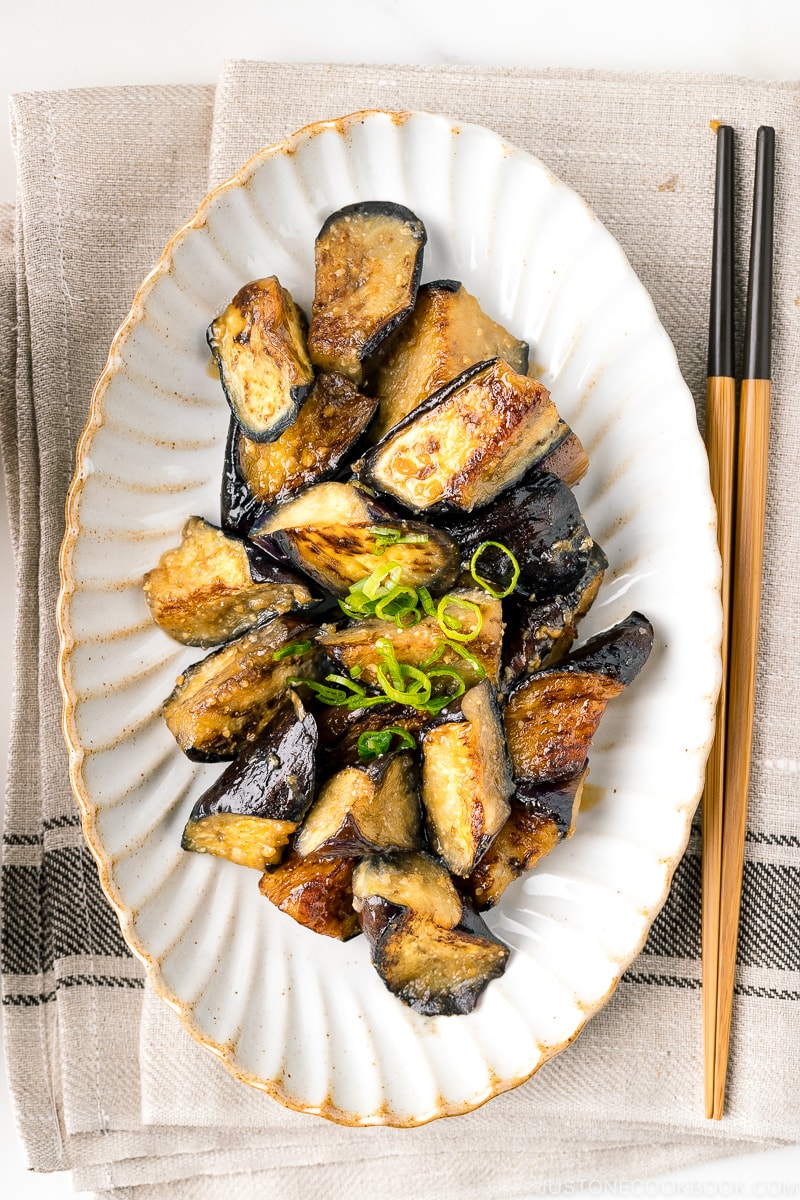
Quick stir fry dishes are perfect for a busy weeknight. I used eggplants today, but the stir-fries are so versatile and you can pretty much use whatever lingering ingredients you have in your fridge. Ready to make this quick meal in just 20 minutes? Let’s go!
Why Eggplants?
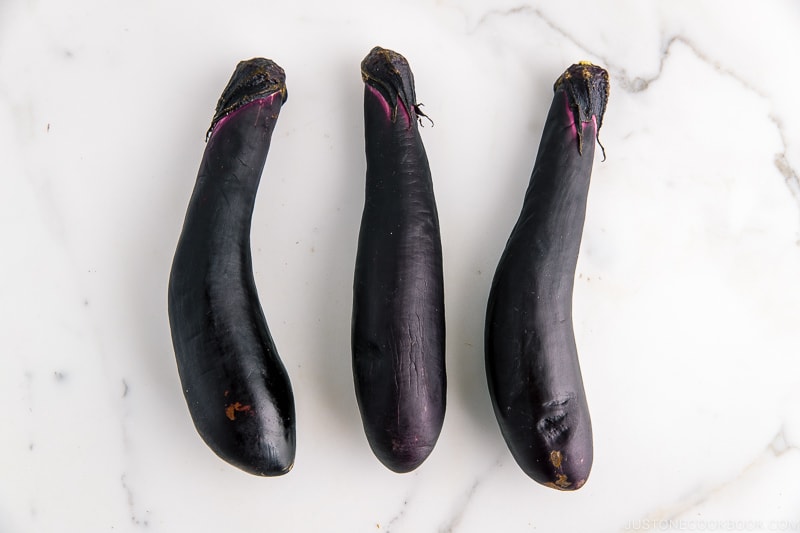
Eggplant and miso are a match in heaven and always the golden combination known by cooks in Japan.
When eggplants are cooked till tender, they absorb like a sponge, sucking up all the delicious seasonings. So if you’re looking for a bold, savory dish that goes well with rice, pick eggplant.
I disliked eggplants growing up and always wondered why my mom cooked this vegetable so often. Now that I’m a mom, I’m doing the exact same. My kids are asking why I always cook eggplant dishes. Well, they haven’t developed the appreciation yet, but I know the days will come:) Eggplants are delicious especially when it’s cooked right!
If you can’t find Japanese/Chinese long eggplant, you can use a globe (American) eggplant, but the key is to keep the skin attached so that eggplant doesn’t lose its shape during stir-frying. The globe eggplant has a glossy and thicker skin than Japanese/Chinese eggplant but it should still work.
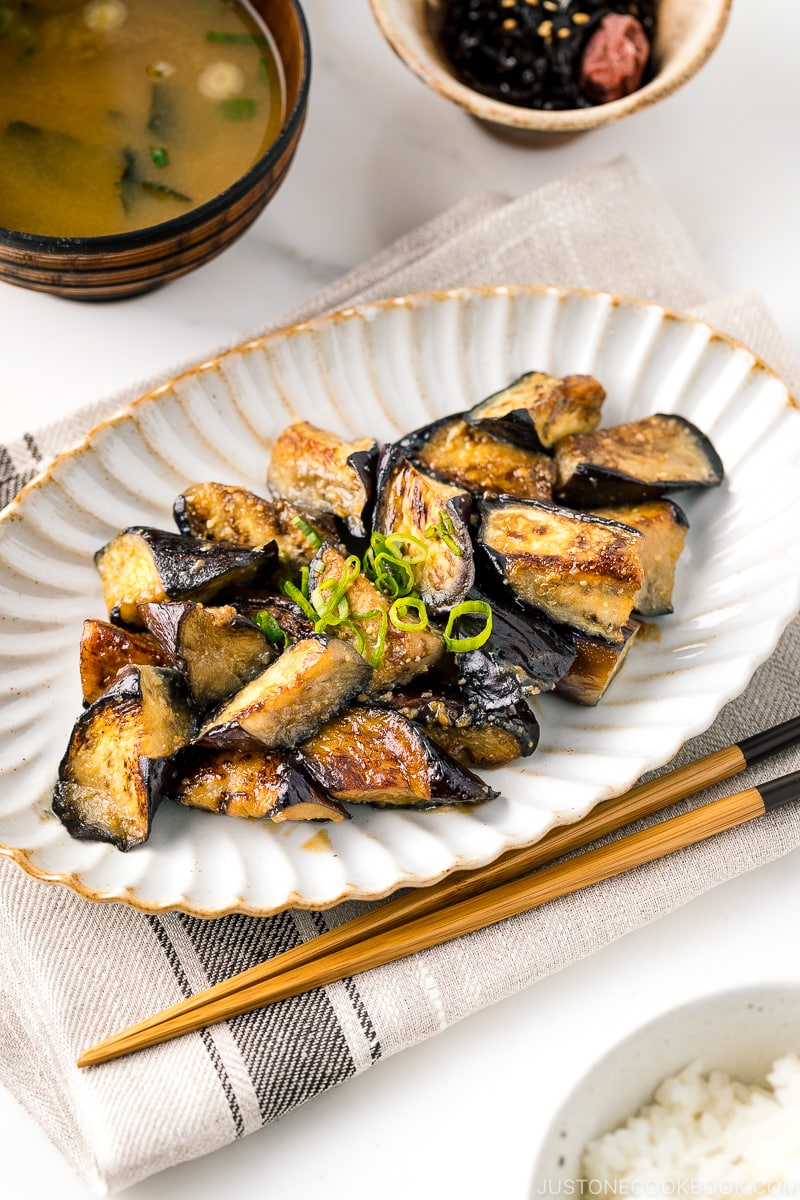
Easy Miso Sauce
There is no special condiments necessary for this everyday dish. Basic Japanese condiments are all you need.
- Miso… more about it below
- Sake
- Mirin
- Soy sauce… a bit of umami instead of salt
- Grated ginger for the zing!
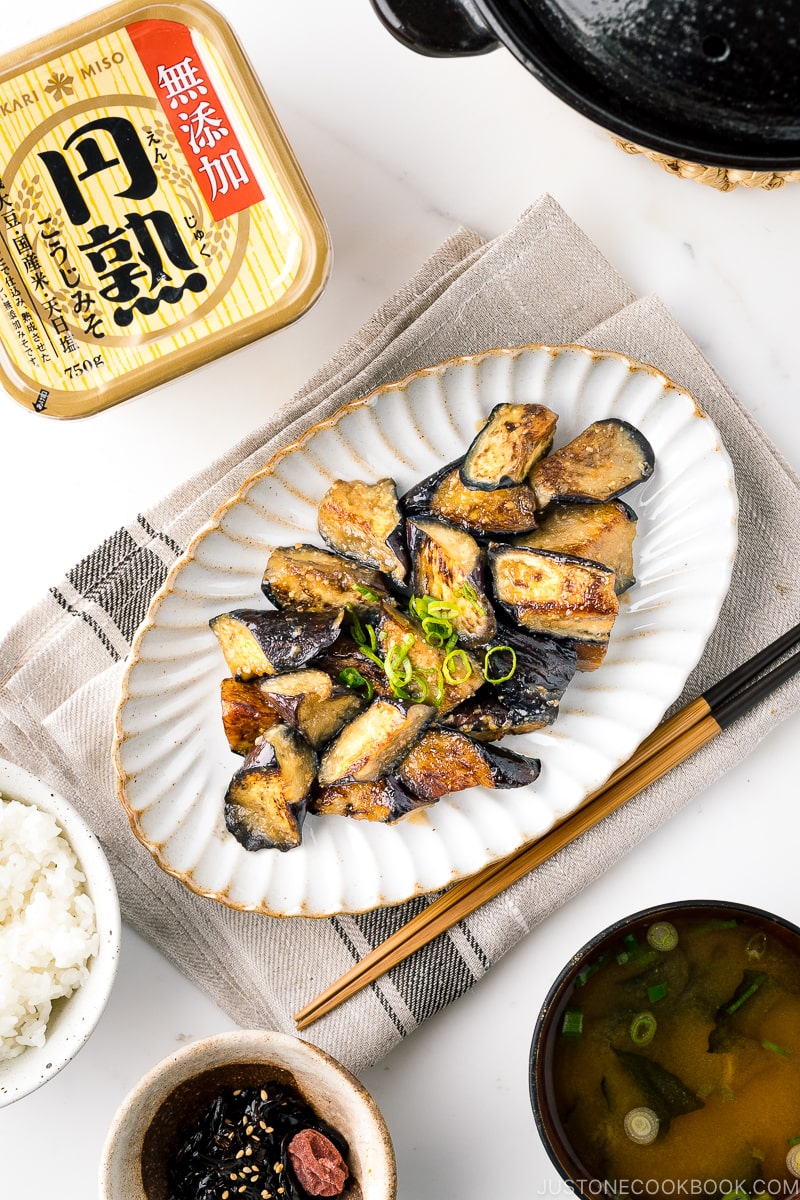
Type of Miso to Use
The miso I used today is Enjuku Koji Miso from Hikari Miso. I’ve been using different miso products from this company and I’m really happy with their quality. We liked their miso so much that we even visited their factory in Nagano, Japan!
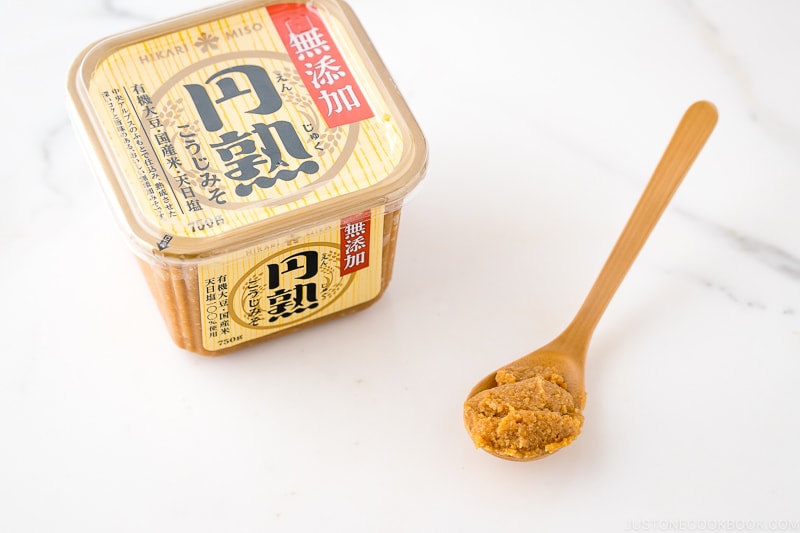
Enjuku Koji Miso is their long-selling product for over 20 years since its introduction in 1993. The preservative-free miso features a mild flavor and rich fragrance incorporated with natural sweetness and robust umami of koji.
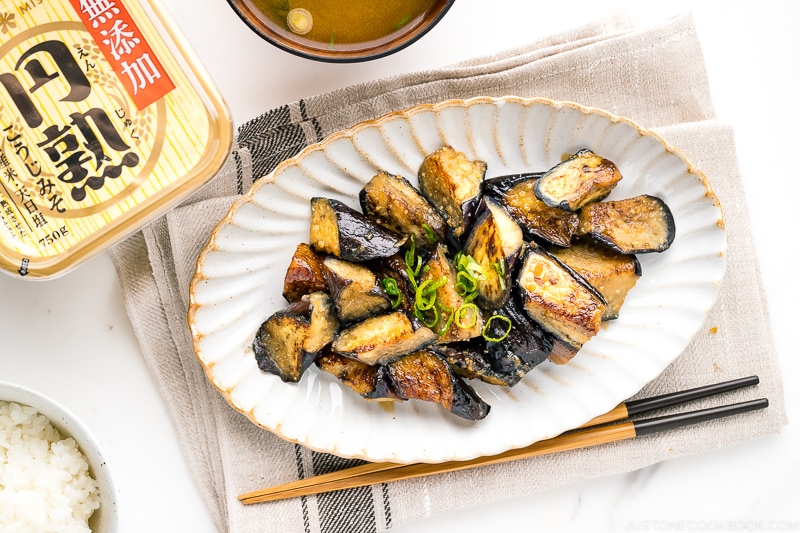
Where to Get This Miso
You can find this miso along with other Hikari Miso products in Japanese/Asian grocery stores.
Substitute
There is nothing that is quite similar to miso. You may wonder about Doenjang, a Korean soybean paste.
Unfortunately, miso and doenjang are made differently. Doenjang is not fermented with rice or other grains (source), and it has a stronger and deeper flavor while miso is milder, smoother, and sweeter due to koji culture.
If you can’t find this specific miso, then use the miso you have at your local store. Just a few tips:
- Dashi-included miso tends to be saltier, so you have to remember to use less or adjust saltiness.
- White miso is lighter, sweeter, and less salty due to a shorter period of fermentation. Red miso is stronger and saltier.
- Each brand of miso has different saltiness, so adjust accordingly.
- There is no “right” miso for this recipe. Different miso, different variation (it’s part of the fun!).
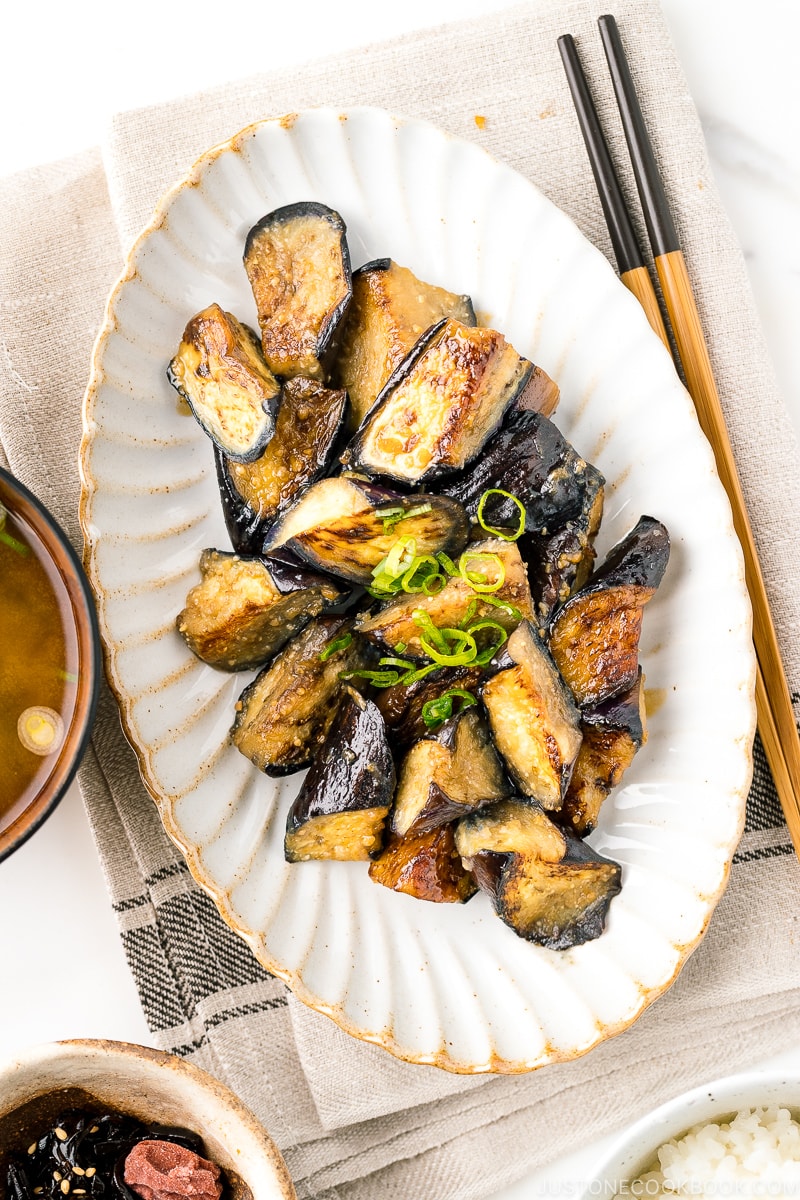
Quick Stir Fry Tip
Are you new to stir fry? Here are some tips you may find useful.
- No wok? Don’t worry! – I use a carbon steel frying pan. Just like my wok, this pan has built up a natural patina and become non-stick over time. It can hold heat better and sear food better than a nonstick pan.
- Don’t be shy on oil – A good amount oil is needed for keeping the wok/ pan hot for stir frying and ensure the eggplants don’t stick.
- Add seasonings last – The sauce, especially miso burns quickly; therefore, assume that you won’t be “cooking” the ingredients after you add the sauce.
- Shake the pan while stir frying – Keep the ingredients moving by shaking the pan.
For more easy and delicious stir fry recipes, here are some of my favorites:
- Stir Fry Vegetables (Yasai Itame)
- Spicy Shrimp Stir Fry (Ebi Cili)
- Kabocha Pork Stir Fry
- Japanese Lotus Root Stir Fry
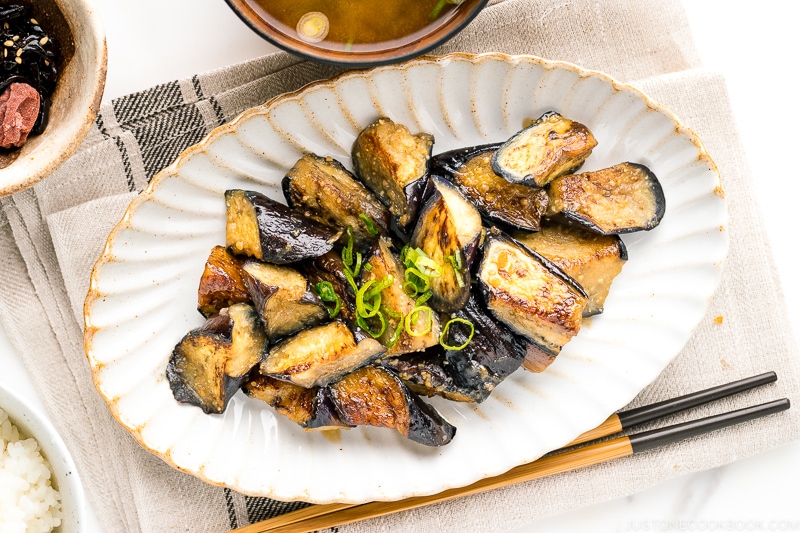
Wish to learn more about Japanese cooking? Sign up for our free newsletter to receive cooking tips & recipe updates! And stay in touch with me on Facebook, Pinterest, YouTube, and Instagram.
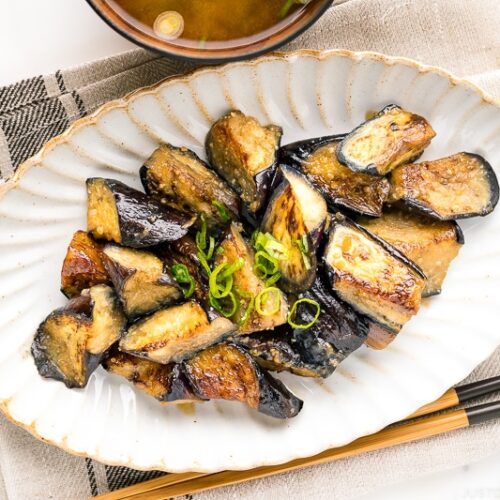
Stir-Fried Miso Eggplant
Ingredients
- 3 Japanese eggplants (roughly 15 oz, 425 g; or use 2 Chinese eggplants)
- 1 green onion/scallion
- ½ tsp ginger (grated, with juice; from a 1-inch, 2.5-cm knob)
- 1 Tbsp neutral oil (for cooking the eggplants)
- 1 Tbsp toasted sesame oil (for cooking the eggplants)
For the Miso Sauce
- 2 Tbsp sake
- 2 Tbsp mirin (if you prefer a sweeter taste, use 1 Tbsp mirin, 1 Tbsp sugar, and 1 Tbsp water)
- 1 Tbsp miso (I used Hikari Miso Enjuku Koji Miso)
- 1 tsp soy sauce
Instructions
- Gather all the ingredients.

To Prepare the Ingredients
- Cut 3 Japanese eggplants into bite-size pieces. I highly recommend using the Japanese rangiri cutting technique, which creates more surface area so the eggplants cook faster and absorb flavors.

- Soak the eggplants in water to remove the astringency and prevent its color from changing. Meanwhile, cut 1 green onion/scallion into thin slices.

- Peel and grate 1 knob ginger (I use a ceramic grater). Collect ½ tsp ginger (grated, with juice).

- In a small bowl, combine all the ingredients for the miso sauce: 2 Tbsp sake, 2 Tbsp mirin, 1 Tbsp miso, and 1 tsp soy sauce. Add in the grated ginger and mix well together.

To Cook the Eggplants
- Drain the eggplants and pat dry with a clean kitchen towel. Heat a large frying pan over medium heat.

- When it’s hot, add both 1 Tbsp neutral oil and 1 Tbsp toasted sesame oil and swirl them in the pan. When the oil is hot, add the eggplant.

- Cook the eggplants on medium heat, flipping them when the bottom side is brown.

- When the eggplants are nicely browned, add the miso sauce. Coat the eggplants with the sauce by shaking the frying pan.

- You may want to flip the eggplants to make sure the pieces are well coated. When the liquid is evaporated, remove the pan from the heat immediately as miso burns easily.

To Serve
- Transfer to a serving plate and garnish with the green onion slices.

To Store
- You can keep the leftovers in an airtight container and store in the refrigerator for up to 3 days and in the freezer for a month.
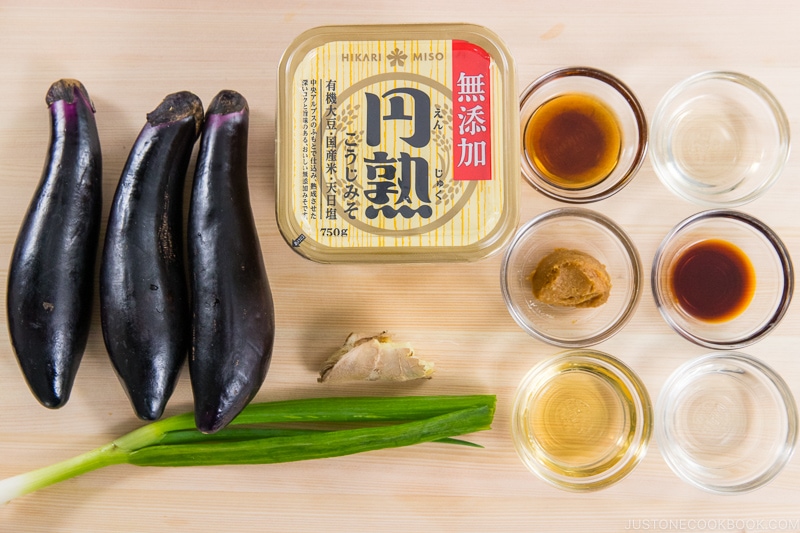
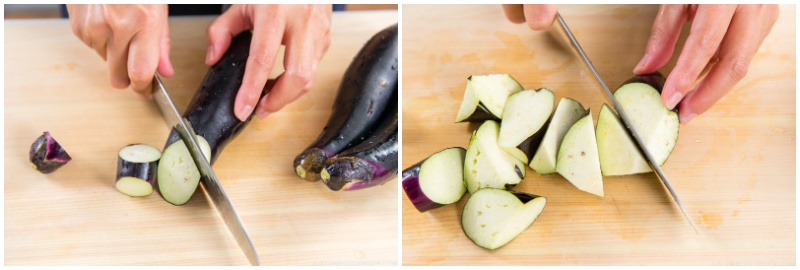
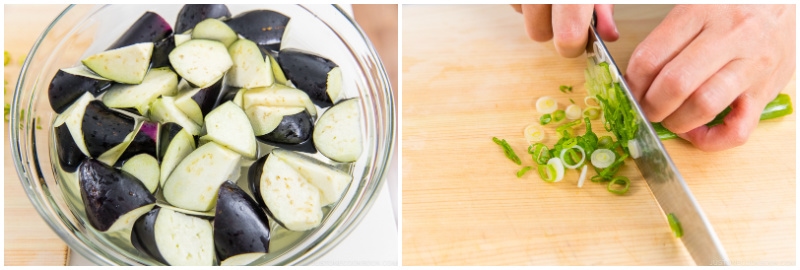
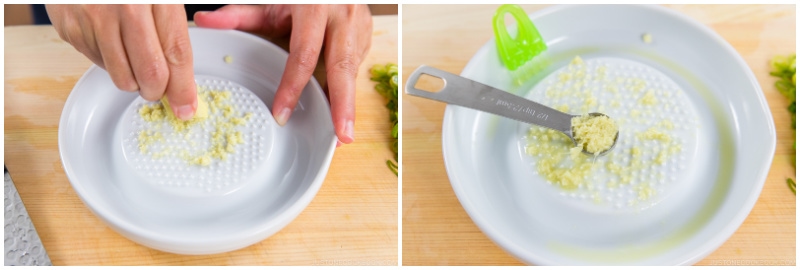
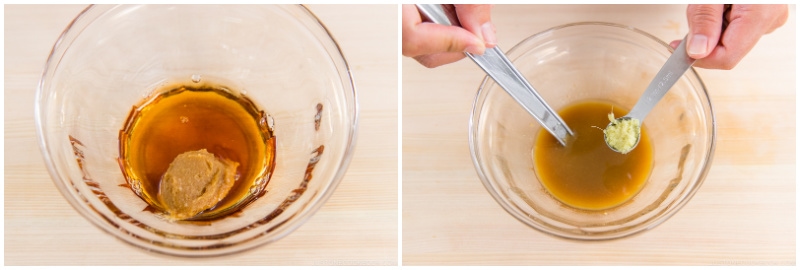
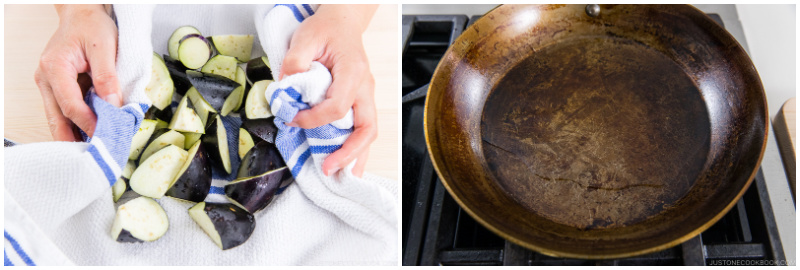
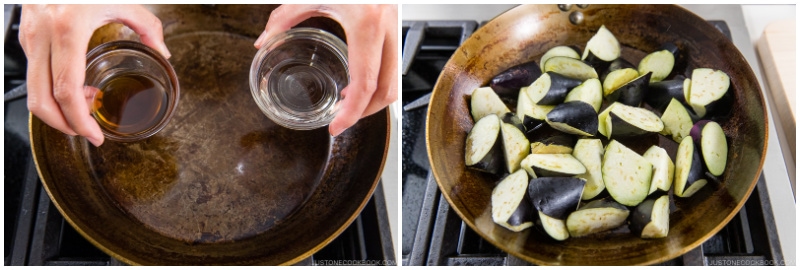
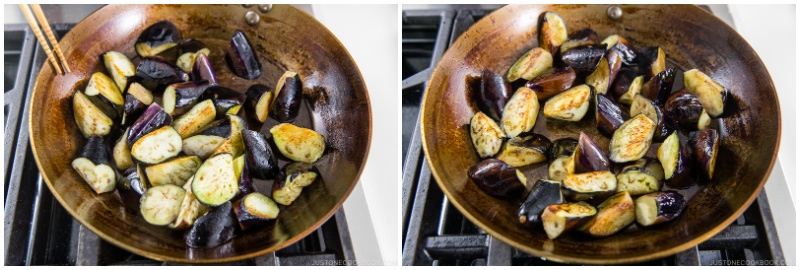
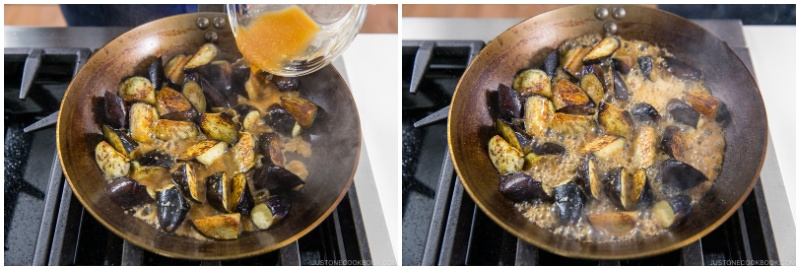
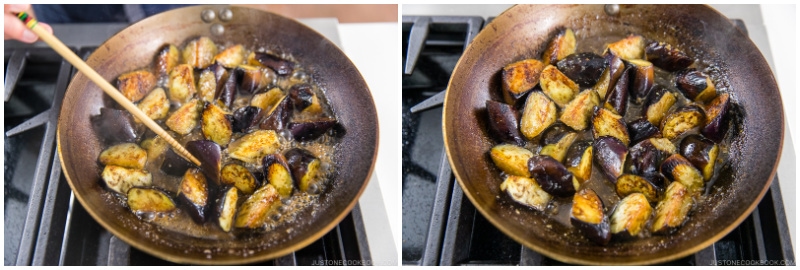
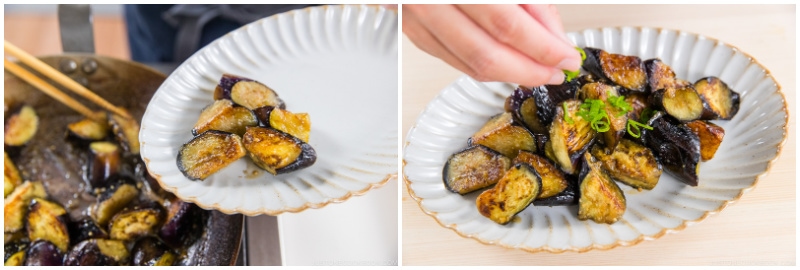










I do not enjoy eating vegetables, but I had this at a Japanese restaurant and it was my favorite thing to eat all evening. I am not a hero when it comes to cooking so I do have one question: We will receive an airfryer shortly and I was wondering if and how I could use for this recipe maybe.
Taste is more important to me, but if I can use the airfryer to reduce the amount of oil and fat being used, that would be even better. 🙂
Hello, Miriam. We’re happy to hear you enjoyed Nami’s recipe! Thank you for your feedback.
To use the air fryer in this recipe, cook the eggplant until step 3, then use a pan to coat the sauce and complete the meal.
We hope this helps to minimize oil use.🙂
Ah…eggplants, a sponge for delicious sauces; yet so under appreciated by many, especially in the US. May be it’s all the seeds in the more widely available globe eggplants that turns them away. Thanks for sharing this delicious recipe and hope it will convert some eggplant haters to give it a try. I would even suggest to cut out a section of the center seeded part if only globe eggplants are available.
Hi Karen! The eggplants are a sponge for delicious sauces, we agree!😊
Thank you for reading Nami’s post and trying her recipe!
I think this is one of the best ways to eat eggplant and very easy to make this recipe. I almost make this every week and combine this with other great Japanese recipes from here. I always enjoy to make the wonderful recipes from here. Thanks again for the inspiration and beautiful recipes!!
Hi Marco! Thank you for your kind feedback!😊
We are so happy to hear you enjoyed Nami’s Eggplant recipe and many others!
Happy Cooking!
This is my now my favorite eggplant recipe! This is the first time I tried soaking eggplant in water first. The texture and flavors came out perfect…will definitely make this again (previously when I’ve made eggplant, it didn’t taste anywhere NEAR how restaurants make it, which I love!). Thank you so much!
Hi chai_caramba, We’re so glad to hear from you that you found Nami’s tutorial and tips helpful.
Thank you very much for trying Nami’s recipe and sharing your experience with us.
I had originally planned on doing your Miso Glazed Eggplant version as I had done that one before but came across this one. It seemed easy enough and went for it. It was very popular tonight, especially with the children! Thanks for another great recipe!
Hi Teri! Aww. We are so happy to hear you and your family enjoyed Stir-Fried Miso Eggplant!
Thank you very much for trying Nami’s recipe and for your kind feedback. Happy Cooking!
So I made a few mistakes: I definitely cut the eggplants too large, I forgot to add the sake and ginger, and I didn’t leave the miso mixture in long enough for my liking, but the taste still came through! I know what adjustments to make and I can’t wait to make this again! Lovely recipe!
Hi Amber, Thank you very much for trying Nami’s recipe and sharing your cooking experience with us! 😊
The recipe, for 4, calls for 6 Japanese eggplants. In parentheses in says 2 Chinese eggplants. Am I supposed to all 8 eggplants?
Hi Tammy! Thank you for trying this recipe!
When you change the servings number, the system can not change the number inside the parentheses.😔
3 Japanese eggplants are about the same size as 2 Chinese eggplants (roughly 15 oz, 425 g). If you plan to make 4 servings, please double the amount and use 6 Japanese eggplants or 4 Chinese eggplants (roughly 30 oz, 850 g). We hope this helps!
I love eggplant and this is a simple yet satisfying dish to try. Love it!
Hi Joan! We are so happy to hear you enjoyed Nami’s recipe!
Thank you very much for your kind feedback.
For how long you soak the eggplants in water?
Hi Mon, Thank you very much for trying this recipe!
The soaking time for eggplant will be about 5~10 minutes while you slice green onion and finish Step 3 and 4.
We hope this helps!
I don’t eat eggplant, so I tried your recipe with tofu. Your sauce was great! thank you, Kale Lani
Hi Kale Lani! Thank you very much for trying Nami’s recipe and sharing your cooking experience with us! What a great idea!
We are so happy to hear you enjoy this sauce with tofu!
I am sure you can try this recipe with zucchini or yellow squash and it will be equally delicious.
I am very pleased to see have this recipe and such nicely presented instructions. There are lots of ideas on the internet but not so many good dishes that are practical to prepare for a one or two person meal. It will be a pleasure to follow you in the future.
Hi John, You have no idea how much your kind words meant to Nami and JOC team!
Thank you very much for your kind feedback.
This would have to be one of the nicest eggplant dishes I have tried. We grow the slender eggplants in the garden and always look for different ways to cook them. Came across this recipe today and gave it a try, OMG how amazing it was. Thank you for your knowledge and inspiration. PS I am in Australia..
Hi Pauline! Thank you very much for trying this recipe and for your kind feedback from Australia!
Nami and JOC team are so happy to hear you enjoyed Stir Fry Miso Eggplant!
I was waiting for this. Eggplant miso itame is
one of my favorite dishes.
Thank you.
Hi Masano! Thank you very much for your kind feedback!
We are glad to hear this is one of your favorite dishes! Happy Cooking!